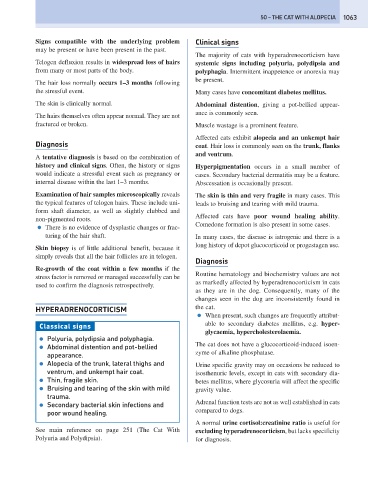Page 1071 - Problem-Based Feline Medicine
P. 1071
50 – THE CAT WITH ALOPECIA 1063
Signs compatible with the underlying problem Clinical signs
may be present or have been present in the past.
The majority of cats with hyperadrenocorticism have
Telogen defluxion results in widespread loss of hairs systemic signs including polyuria, polydipsia and
from many or most parts of the body. polyphagia. Intermittent inappetence or anorexia may
be present.
The hair loss normally occurs 1–3 months following
the stressful event. Many cases have concomitant diabetes mellitus.
The skin is clinically normal. Abdominal distention, giving a pot-bellied appear-
ance is commonly seen.
The hairs themselves often appear normal. They are not
fractured or broken. Muscle wastage is a prominent feature.
Affected cats exhibit alopecia and an unkempt hair
Diagnosis coat. Hair loss is commonly seen on the trunk, flanks
and ventrum.
A tentative diagnosis is based on the combination of
history and clinical signs. Often, the history or signs Hyperpigmentation occurs in a small number of
would indicate a stressful event such as pregnancy or cases. Secondary bacterial dermatitis may be a feature.
internal disease within the last 1–3 months. Abscessation is occasionally present.
Examination of hair samples microscopically reveals The skin is thin and very fragile in many cases. This
the typical features of telogen hairs. These include uni- leads to bruising and tearing with mild trauma.
form shaft diameter, as well as slightly clubbed and
Affected cats have poor wound healing ability.
non-pigmented roots.
Comedone formation is also present in some cases.
● There is no evidence of dysplastic changes or frac-
turing of the hair shaft. In many cases, the disease is iatrogenic and there is a
long history of depot glucocorticoid or progestagen use.
Skin biopsy is of little additional benefit, because it
simply reveals that all the hair follicles are in telogen.
Diagnosis
Re-growth of the coat within a few months if the
Routine hematology and biochemistry values are not
stress factor is removed or managed successfully can be
as markedly affected by hyperadrenocorticism in cats
used to confirm the diagnosis retrospectively.
as they are in the dog. Consequently, many of the
changes seen in the dog are inconsistently found in
HYPERADRENOCORTICISM the cat.
● When present, such changes are frequently attribut-
able to secondary diabetes mellitus, e.g. hyper-
Classical signs
glycaemia, hypercholesterolaemia.
● Polyuria, polydipsia and polyphagia.
The cat does not have a glucocorticoid-induced isoen-
● Abdominal distention and pot-bellied
zyme of alkaline phosphatase.
appearance.
● Alopecia of the trunk, lateral thighs and Urine specific gravity may on occasions be reduced to
ventrum, and unkempt hair coat. isosthenuric levels, except in cats with secondary dia-
● Thin, fragile skin. betes mellitus, where glycosuria will affect the specific
● Bruising and tearing of the skin with mild gravity value.
trauma.
Adrenal function tests are not as well established in cats
● Secondary bacterial skin infections and
compared to dogs.
poor wound healing.
A normal urine cortisol:creatinine ratio is useful for
See main reference on page 251 (The Cat With excluding hyperadrenocorticism, but lacks specificity
Polyuria and Polydipsia). for diagnosis.

